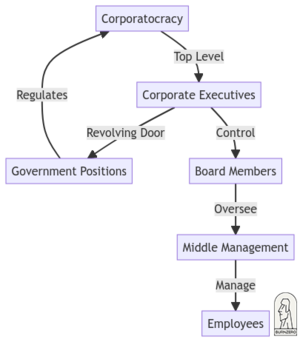Corporatocracy
Corporate entities have a significant advantage over human independent businesses as although they are considered equal in law[1], they cannot go to jail. This ability has given them a key competitive advantage to become the most dominant form of organisation on the planet.
Today corporations, which lack feeling and human empathy are the main influencers of governments around the world. Due to non-transparency this is hidden from the public eye and has lead us to a new hierarchy, the corporatocracy (Figure 1).
The rise of corporatocracy can be attributed to several factors:
- Globalization and Economic Liberalization: The advent of globalization has allowed corporations to operate across national boundaries, gaining significant influence and power. Economic liberalization policies have also facilitated the growth and influence of corporations.
- Political Influence and Lobbying: Corporations often have significant financial resources at their disposal, which they can use to influence political processes. This can be done through lobbying, campaign contributions, and other forms of political spending.
- Control Over Resources and Markets: Corporations often have control over significant resources and markets. This control can give them a disproportionate amount of power and influence over economic and policy decisions.
- Public-Private Partnerships: In many cases, governments and corporations work together in what are known as public-private partnerships. While these can have benefits, they can also lead to a situation where corporate interests have a significant influence over public policy.
- Financialization of the Economy: Over the past few decades, there has been a trend towards the increasing role of financial markets, financial motives, financial institutions, and financial elites in the operation of the economy, which has increased the power and influence of corporations.
While corporatocracy can lead to economic growth and development, it can also lead to income inequality, environmental degradation, and a lack of public control over resources and policy decisions.
Reference
- ↑ Santa Clara County v. Southern Pacific, U.S. Supreme Court (1886): 118 U.S. 394. Decided: May 9, 1886. Accessed 6th Jan 2022 via https://supreme.justia.com/cases/federal/us/118/394/

